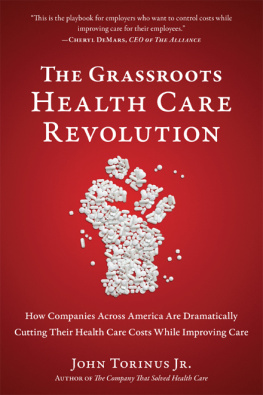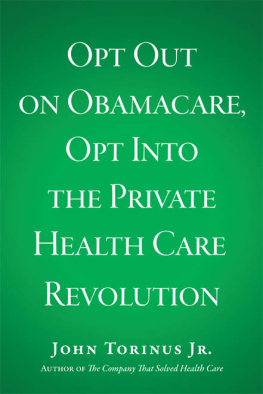
PRAISE FOR THE GRASSROOTS HEALTH CARE REVOLUTION
This is the playbook for employers who want to control costs while improving care for their employees. John Torinus, Serigraph, and other leading-edge companies show whats possible by being bold and applying common sense strategies to health-benefit management. If enough employers followed suit, theyd change the market while getting better results for their employees and their companies.
CHERYL DEMARS,
CEO of The Alliance
As John Torinus points out, for most CEOs, health care is the second or third largest element of their cost structureand generally the most undermanaged significant cost. His new book lays out a three-year transition from unmanaged health care to a health system that provides dramatically improved participant health with dramatically reduced costs.
GEORGE KOENIGSAECKER,
author of Leading the Lean Enterprise Transformation
The 2,700-page Patient Protection and Affordable Care Act was signed into law by President Obama on March 23, 2010. As the law approaches its fourth anniversary, it is clear that the United States will achieve neither lower costs nor universal coverage under this plan. Instead, Obamacare increases the role of the federal government in our health care system which will lead to long waits, rationed care, and a lack of access to the latest technology and treatments for all of us. In order to achieve affordable, accessible, quality care for all Americans, we need a system that empowers doctors and patients and awards innovation. In his new book, The Grassroots Health Care Revolution: How Companies Across America Are Dramatically Cutting Their Health Care Costs While Improving Care, John Torinus shows through his many interviews with employers and employees how a patient-centric model of reform is the solution to what ails our system. This book is a must read.
SALLY C. PIPES,
President and CEO of the Pacific Research Institute
and author of The Cure for Obamacare
John Torinus has been experimenting with improving health care cost and quality in his company for over a decade. His work at Serigraph Inc. in Wisconsin clearly shows employers can radically reduce the total cost of health care benefits while still maintaining employee choice. Torinus succinctly explains how employers anywhere can offer great health care benefits at much less cost. This is a must read for any leader struggling to manage their health care costs.
JOHN TOUSSAINT,
CEO of Center for Valued Based Healthcare
PRAISE FOR JOHN TORINUS AND THE COMPANY THAT SOLVED HEALTH CARE
John Torinus is a national treasure. Every business can learn from what he did at Serigraph.
REGINA E. HERZLINGER,
Nancy R. McPherson Professor of Business Administration
at the Harvard Business School, author of Who Killed Health Care?
The health care industry is badly in need of new business models and systems thinking. The Company That Solved Health Care incorporates some of the best management disciplines as it proves health and health care costs can be improved dramatically at the ground level.
PAUL ONEILL,
former CEO of Alcoa and Secretary of the Treasury
Torinus has sought out the best innovators in Wisconsin for delivering more value in health care, and he put them to work at Serigraph. His company has proved that purchasers of health care can manage their costs and control their destiny far more effectively than command and control government approaches. He has pushed the industry hard to improve, and it has helped us get better. His prescription is on the mark.
STEVE BRENTON,
President, Wisconsin Hospital Association
While much of the country is focused on the attempts to reform health care in Washington, there is a revolution going on under their noses. This book describes the real-world revolution that is transforming health care into a cost-efficient, accountable system through empowering consumers. John Torinus is no dreamer. He shows us how his company has walked the walk and actually made it happen. This is must-reading for every employer who is concerned about staying in business in a difficult economy.
GREG SCANDLEN,
Editor, Consumer Power Report
Manitowoc County took a page directly out of the innovations for managing health care costs spearheaded by John Torinus at Serigraph, and it worked. We convinced our non-represented employees and six employee bargaining units to work with us in making these changes, putting millions of dollars into the pockets of our four hundred employees while capturing significant savings for taxpayers. Consumer-driven health care changes EVERYTHING!
BOB ZIEGELBAUER,
Wisconsin State Representative (D)
and Manitowoc (WI) County Executive
Torinus has succinctly chronicled the remarkable success at Serigraph in controlling company health care costs. This story serves as evidence to U.S. employers and the government that its possible to bend the health care expense curve. His prescription? Work with employees to help them become better consumers by providing price and quality data on doctors, hospitals, and prescription drugs so they can take responsibility for their own health, and by creating benefit incentives that encourage the right behaviors. This isnt academic theory. Torinus has made it work.
JOHN TOUSSAINT,
CEO, ThedaCare Center for Healthcare Value
Prevention, wellness, and chronic disease management have to be foremost if the nation is going to dramatically improve health and significantly lower costs of care. Serigraphs business model proves those initiatives work in a very real way. The book is a must for every business as it deals with health care.
TOMMY THOMPSON,
former Governor of Wisconsin and
Former U.S. Secretary of Health and Human Services
Anyone hoping to sit quietly on the sidelines until John Torinus tires of his campaign to change health care in our country would do well to remember that John rode his bike across America at age 71 and skis through the hilly and frigid course of the American Birkebeiner. John brings the focus and energy of an endurance athlete to his work to keep his company competitive by changing the way we buy and, more importantly, think about health care.
Since I met John in 1996, he has been an active participant in health reform debates and a relentless voice for change. We were at the table together when a small group of Wisconsin providers started down that path of transparency as part of the Wisconsin Collaborative for Health Care Quality. Those initial steps were a leap of faith as providers began to share quality and cost data with customers and each other. This work set a path for larger initiatives, like the Wisconsin Hospital Associations Price Point and Check Point. Wisconsin is now considered a national leader, due in some measure to that early work.
His book offers the reader a birds-eye view of the changes and innovations John shepherded at Serigraph. Like all good innovators, John keeps experimenting and has hits and misses. While I am not in total agreement with all that John has proposed for his workers (for example, I share his co-workers skepticism about medical tourism), clearly his focus on staff engagement is key to any health reform effort. This is a critical point whether at the work area or in the national reform agenda. His prescription offers insights into the winning strategy of empowering individuals to take an active role in managing their health. The focus on wellness, prevention, and end-of-life planning yield more impressive benefits than cost savings: some of Johns coworkers will no doubt live longer and live better because they were offered the right incentives and support to catch disease early or take steps to prevent it altogether.
Next page






